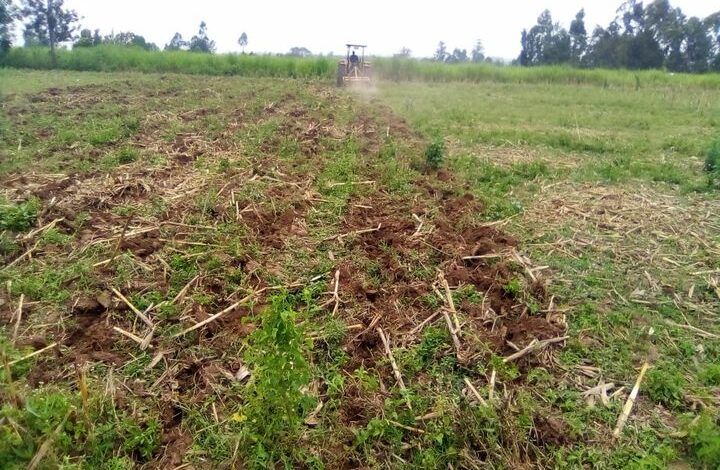Kenyan Farmers ripping big from small-scale agricultural irrigation-cum-value addition project

The agricultural sector provides a livelihood for about 80 per cent of Kenya’s population, most of whom are subsistence farmers in rural areas. According to the Ministry of Agriculture, the sector contributes about 24 per cent to the GDP and another 27 per cent indirectly through sector economic linkages; it accounts for 65 per cent of the country’s export earnings.
Food production was badly affected leading to prices of commodity skyrocketing to the highs of 5.29 percent that year, based on World Bank figures.
However, thanks to government project funded by the African Development Bank things could not get out of hand for the Kenyan rural population.
“Farmers are making good money through value addition”, said Professor Hamadi Boga, Agriculture Principle Secretary in Kenya’s ministry of agriculture.
Extension services affected
According to the Principle Secretary in the Ministry of Agriculture, a group staff in the ministry, mostly those aged over 50 were advised by the government to stay away from their offices and avoid interaction with people in bid to mitigate possibilities of Coronavirus infection last year.
This greatly affected agricultural extension services, which have suffered since 1990s when the country adopted the Breton Wood Institution’s recommendations of the structural adjustment programme which saw the government cease employment. These resulted in drastic changes in terms of public financial management, marketing and pricing systems as a part of economic reforms and liberalization.
Prod Boga said the reduced number of extension service officers led to reduction in the interaction time between farmers and agricultural experts.
According to Boga, COVID-19 affected the agricultural sector mainly in two main ways. Besides affecting the extension services, the elderly women rural farmers also feared taking their produce to markets for fear of getting infected.
Besides even the dare-devil farmers that decided to take their produce to the markets were met with empty market stalls as regular, urban based dwellers shunned interacting with rural farmers.
Small-scale irrigation project
The Small-scale Irrigation and Value Addition Project (SIVAP) was conceived by the Government of Kenya (GoK). The need for this project emanated from the lessons learnt from, and the need to upscale, the concluded Small-Scale Horticulture Development Project (SHDP).
According to Prof Boga, the project has four major components including enhanced water infrastructure development, Improved Access to Markets and Strengthening of Value Chains and Institutional strengthening and capacity development and Project Coordination and Management.
He added that this project specifically seeks to offer alternatives to reduce dependency on inadequate rainfall for agricultural production. “We did pilots on this and it had great potential”, he said adding that the government hopes to improve the overall food security situation in the country.
Small scale farm families in at least five counties, namely Kajiado, Bomet, Tana River, Meru and Tharaka Nithi are benefiting from this project.
Loyce Gatwiri, a small-scale farmer from Tharaka Nithi says her Marimanti sub-location hardly gets any rain but the irrigation project has come in on time to help.
“We get water from the project which we use to plant vegetables. Besides, the community around here gets water for their livestock. Farming activities have increased and so are the incomes,” she told reporters supported by the Kampala-based InfoNile, a project of the Nile Basin Initiative to which Kenya is a member.
This project strives to bring out various aspects on this assignment including the nexus between COVID-19 and climate change in addition to the gender perspectives on irrigated farming. Women farmers are major beneficiaries.
According to Prof Boga, the beneficiaries include 104,000 farmers making a total of 520,000 persons – 58% of whom are women and youths in eleven counties of the country.
“Women are being empowered and it is very encouraging. We hope to expand the project in future with increased funds”, he adds.
The project will result in increased incomes and food security in these communities with increased economic off-farm activities as well”, says Prof Boga.
He adds that associated agribusiness, social aspects within these communities where the projects and components are situated and families or beneficiaries. “Value addition is an important component of income to farmers. It is the best way that we can motivate more farmers to venture into farming.
“We hope to add more counties based on the availability of resources. There is a potential to reach about 650,000 small scale farmers in the next two years. We are targeting arid and semi-arid areas of the country”, he adds.
Additional beneficiaries
The project includes lessons such as timely involvement of beneficiaries in design, following integrated catchment-based approach, irrigation command area development and training as part of the design.
According to Prof Boga, significant proportion of the Kenyan population lack access to adequate food and this is more severe in the arid and semi-arid lands.
He says that to secure food production, there is need to minimize dependency on rain-fed agriculture by utilizing water resources for irrigation under sustainable environmental management.
This young project focuses on improving high value crop production rough construction / rehabilitation of twelve (12) small-scale irrigation schemes (2,905 ha) and micro-irrigation projects in eleven counties.
In addition to improved irrigation infrastructure, the project will also focus on improved access to markets, enhanced agro-processing, storage and post-harvest handling technologies, nutrition; and institutional and human capacity building.
Brian Kantai, a beneficiary from Kajiado noted that thanks to the training on product diversification, farmers are able to also use the water to enhance plants that can boost the bee population that could help in crop pollination. “You see we have diversified this project, the bees benefit from the water too, bees need water and nectar to make honey, without which they cannot even enter the hives we have here.”
The project will help the government achieve the core objectives in Sustainable Development Goal (SDG), that is poverty alleviation, food security and improved nutrition; and promote sustainable agriculture. In addition, promote gender equality and empowerment of women through their involvement in project activities.







